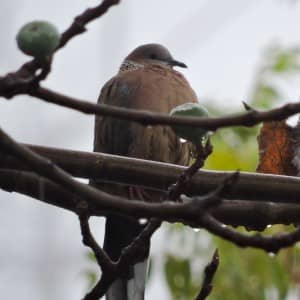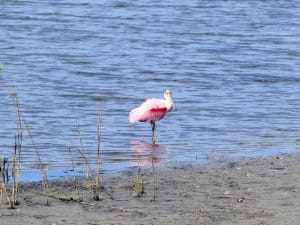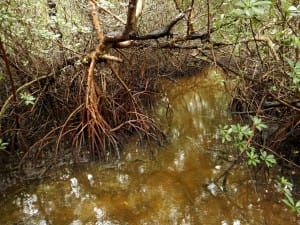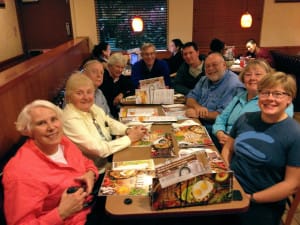Florida Trip Report
Feb 3, 2016 | by Greg Miller
Another week whooshed by! And El Niño strikes again with cooler weather and heavy rains. We saw a total of 159 species despite the inclement weather.
Our first full day of birding started out with an unexpected bird! Soon after we arrived at Viera Wetlands I heard a King Rail call. And then we all got to see it near the gazebo! Wow! Nice bonus bird! Sorry. No pics. It all happened too fast. And a two bittern day is always a good one. Another bonus bird was a well hidden Least Bittern. Score! Our team of sharp-eyed birders picked this one out while riding in our van around the dike! Other Florida regulars included Mottled Duck, Wood Stork, Great and Snowy Egrets, Tricolored and Little Blue Herons, Black-crowned Night-Heron, White and Glossy Ibis, and Boat-tailed Grackles.
On our way north we stopped at Helen and Allan Cruickshank Sanctuary in Titusville to look for the endangered Florida Scrub-Jay. We were not disappointed.
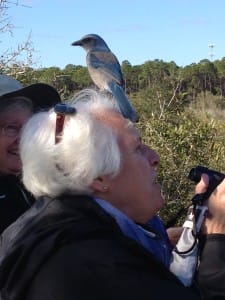
Florida Scrub-Jay on Susan’s head – Helen & Allan Cruickshank Sanctuary – Titusville – FL – 2016-01-25 – Greg Miller – iPhone 4S
Bald Eagles were in flight there. An Eastern Towhee called. And a very early arriving Purple Martin flew by.
At Parrish Park on the way to Merritt Island we saw Black Skimmers on the beach. Fish Crows were calling. And all I could see in flocks of waterfowl were lots of Lesser Scaup. I did find a Great Black-backed Gull perched on a distant island.
The water at Merritt Island NWR was higher than normal due to all the recent rains. Bird numbers were as low as I’ve ever seen them. It was disappointing to me but it was still special to our team. At the entrance we found 2 Reddish Egrets feeding in their very distinct fashion. A handful of waterfowl helped out the species list. Roseate Spoonbills were our first for this trip.
We visited a local feeder and had several Painted Buntings visit. My photos through the shades did not turn out well. But the buntings were absolutely stunning! Afterwards we headed north to Daytona Beach Shores to watch the gulls fly in. It’s a staging area. Numbers there were lower than normal, too. We did manage to see several Lesser Black-backed Gulls and a bully pirate Parasitic Jaeger chasing and scaring gulls and then snatching their food. We drove inland and stayed in DeLand for the night.
We arrived at the southern portion of Ocala National Forest just after sunrise. Our hike into this area of Florida Sandhills produced a 7-woodpecker day including the rare Red-cockaded Woodpecker! Brown-headed Nuthatches were a delight. We encountered several feeding flocks of warblers (mostly Yellow-rumped, Palm, and Pine). Lake Apopka is only open Friday-Sunday so we drove on to our next stop–Lakefront Park at the north end of Lake Tohopekaliga near Kissimmee. This was our very first warm period on our Florida trip. Muscovy Ducks were off to the east of us. Limpkins were feeding in the waters near us. And the real gem was Snail Kite. Chris Brown’s sharp eyes picked out the Snail Kite perched at a distance. But as we waited, a female Snail Kite flew in much closer affording good views for all.
Joe Overstreet Rd and landing almost always holds surprises. We got more looks at Limpkins and Snail Kites and Sandhill Cranes. Nothing else unusual was there. Well. What was unusual was not finding any Crested Caracaras. We missed them at Viera. We missed them here. And no bluebirds? What’s up with that?
We finished the day with some daylight left since we still had a couple hours of driving to get to our next hotel. We stayed overnight near Delray Beach. It had already begun raining when we arrived. It would continue raining all night long.
The rain was relentless and the skies were dark the next morning.as we arrived at Wakodahatchee. This is a remarkable place where herons, egrets, ahingas, and storks are often very close. And the parking lot is small and full. But today it was empty save for our van. And there was only a security guard in a covered golf cart. We had the boardwalk to ourselves in pouring rain.
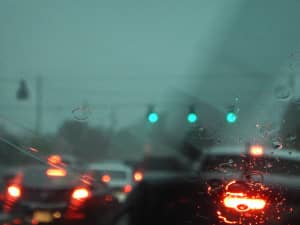
wet participants birding from gazebo – Wakodahatchee – FL – 2016-01-27 – Greg Miller – Nikon Coolpix AW120
I opted to put my phone and billfold into individual zip-lock bags and not wear a coat. My jacket is not truly waterproof. After a while it gets wet and eventually I am drenched anyway. It was raining so hard though that I got soaked through in a few minutes. My pants got so wet that the water ran into my waterproof hiking boots. The boots are good at keeping water out. Today I found out they are just as good at keeping water inside. Squish-squash. Squish-squash. It’s not the sound that your boots are supposed to make. We walked the whole boardwalk in the driving rain.
We were able to eke out 1 Gray-headed [Purple] Swamphen, a couple Purple Gallinules, and a very hard-to-find Neotropic Cormorant. The cormorants had their heads tucked in and picking out a “smaller” cormorant with a shorter tail was hard. We watched it long enough (seemed like an eternity in the rain) for it to raise its head to confirm its identity. All the birds had their heads tucked in, or were huddled under bushes or trees to get out of the rain. Unlike these birders.
After our struggle at Wakodahatchee we decided to skip Green Cay which has an even longer boardwalk. And it just may have been raining even harder. So we drove to Walmart and I ran inside and bought towels for everyone. We were drenched. And cold.
We had lunch at a nearby sandwich place. I sat on some wicker furniture. My clothes were so soaked that it left a small lake under my chair. (I left extra on the tip to drain the lake <grin>)
We found Monk Parakeets and Egyptian Geese along some city streets in the rain as we headed south. At Markham Park, the Spot-breasted Orioles were strikingly beautiful. There were 5 of them in one tree. We had to work in spotty rain to get a brief view of the Western Spindalis (formerly called Stripe-headed Tanager). It started to rain again in earnest as we left.
We finished the day with some soggy Burrowing Owls and flyover Egyptian Geese in southern Broward County. We stopped for the night in Hollywood. (Florida, that is)
The next morning we were on the road at 5:00am. We wanted to be at Bunche Beach in between tides. But the 2 1/4 hour drive turned into a longer one. With necessary bathroom stops. And breakfast. And did I mention rain? Yes. It’s still raining.
At Bunche Beach there was no Mangrove Cuckoo on the drive in. (was there yesterday) And no flamingo was seen at the beach. We hiked both directions. Near the canal we had both Piping and Wilson’s Plovers. It was a hard miss. The cuckoo is never a sure thing in a hurry. But the flamingo had bedazzled many birders daily for more than a week. We left the beach and drove over the bridge to Sanibel Island to visit Ding Darling NWR. Unfortunately, the water was quite high due to the rain. Birds were few.
Even though it was cool and we had rain off and on there was traffic at Ding. It took almost an hour and a half to make the loop. We only added Yellow-crowned Night-Heron. Across the other side of the island Gulfside Beach had lots of people walking on the beaches. We scanned up and down the beach but had no luck finding the Ninja Snowy Plovers. And we were short on time. We ate a quick lunch and drove east toward Six Mile Cypress Slough. We had almost arrived when Chris got a call. The flamingo had returned! We did a U-turn and drove the agonizingly long 20-minute drive back to Bunche Beach. When one is chasing a report of a rare bird time seems to go slower. When we arrived at Bunche Beach we unloaded the van in the rain at the circle. The flamingo was already in flight! We watched the bird as it flew back and forth a couple times before disappearing in distant fog. Had we been 2 minutes later we would have missed it altogether! Everyone got good looks at the bird in flight. Too bad we didn’t get killer “Miller Views” like the birders did on every day before us. On the way out we had a flyover Magnificent Frigatebird! Another bonus bird.
We headed back to Six Mile Cypress Slough in hopes of finding a Short-tailed Hawk. But pouring rain was with us again and we dipped on the hawk. With the hours in the day fading away we left Six Mile and headed east to an eBird location in Hendry County for Scissor-tailed Flycatcher and Western Kingbird. We dipped on the flycatchers but found 4 Crested Caracaras on the ground under a cabbage palm in the field. We left in fading light and drove north. We stayed overnight east of Bradenton.
We arrived at Fort Desoto Park near sunrise. The walk out to the fishing pier was chilly but clear finally. No rain in the forecast. We also checked out an area with small inlets and found oystercatchers and Reddish Egrets. Still no sound of Nanday Parakeets in the north end of the park. A lady came up to meet me. Her name was Sharon Pratt. She asked if we had Great Horned Owl yet. We did not. She took us to a nest she had found the day before. Thank you Sharon!
We left Fort Desoto Park and drove many city streets of St. Petersburg, checking eBird locations for Nanday Parakeet but with no success. We should call them Ninja Parakeets. After that we drove inland to Circle B Bar Reserve for Black-bellied Whistling-Ducks. I still can’t believe we did all that birding during the week and have missed such an easy find in Florida. We hiked about a mile into the area and found no ducks at all. Nor did anyone there seem to remember seeing any ducks. Aargh! Too much time for an easy bird. We turned around and hurried out of the reserve and drove with remaining daylight to Lake Apopka.
At Lake Apopka we finally found alligators. We had only seen one until now. Unbelievable, right? In fact, our first warm, non-rainy day produced LOTS of alligators!
Our waiting at a specific spot turned out to be fortuitous. We had a couple small flocks of Black-bellied Whistling-Ducks and…<drumroll>…another bonus bird! A small flock of the more unusual Fulvous Whistling-Ducks landed near us. We were able to get telescope views of this handsome duck.
All in all, it was a grand trip. The Big Year Tours grand total now stands at 279 species. The goal of 500 species still looks feasible. And $1100 has been raised for American Birding Association’s Young Birders!
If you haven’t do so yet, why not consider doing a fun birding trip with that silly birder portrayed by Jack Black and help raised money for ABA Young Birders at tje same time? Check out bigyeartours.com

































